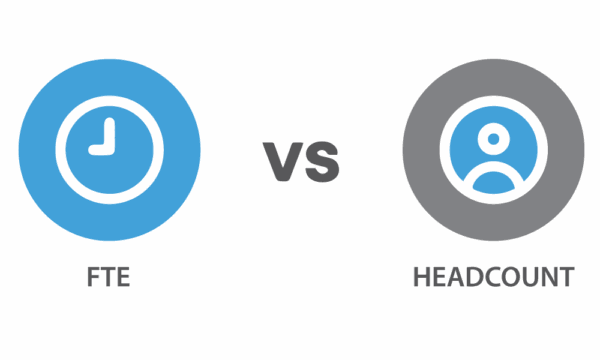In economics, equilibrium refers to a state where supply and demand are perfectly balanced, ensuring that the quantity supplied by producers matches the market’s demand. This balance results in fair prices, satisfying all parties involved—a theoretical win-win situation.
Similarly, businesses must strike the right balance when it comes to their workforce to meet customer demands effectively. Having too few employees can lead to missed opportunities, delivery delays, and overworked staff, while an excess of employees can result in underutilisation, cash flow problems, and disengaged team members.
However, determining the “perfect” number of employees for your business can be challenging. Employee costs are often one of the largest fixed expenses for a business.
In this blog, we look at ways you can assess if you have the right balance of employees for your business.
Jump to:
- How many employees should my business have?
- What is an ‘FTE’
- Why FTE Matters More Than Headcount
- How to Determine Your Optimal FTE Number
- The win-win-win of the FTE equilibrium
How many employees should my business have
The short answer is: it all depends on what industry you’re in. This number can vary greatly depending on the service or product delivered.
Additionally, it’s important to look at the FTE figure, not the total employee headcount. This ensures you are analysing
What is an ‘FTE’
In Australia, FTE stands for Full Time Equivalent, a measurement that represents the workload of an employee in terms of standard hours. It’s important to note that FTE is not the same as headcount; rather, it reflects the total hours worked by all employees relative to a full-time workload.
This includes employees who are:
- Full-time
- Part-time
- Casual
- Fixed-term
- Shift workers
- Daily hire and weekly hire
- Apprentices and trainees
- Outworkers
It does not include:
- Sub-contractors
- Consultants
- Work experience students
Calculating FTE involves counting all hours worked by employees, including full-time, part-time, casual, and other categories, and then dividing by the standard workload hours. This calculation is used to understand true productivity, ensuring accurate resource allocation, and determining eligibility for government subsidies and grants.
For more information on determining the number of FTEs in your business, see our Benchmarking FTE calculator here: https://benchmarking.com.au/business-benchmarks/full-time-equivalent-benchmark-calculation/

Why FTE Matters More Than Headcount
Using FTE instead of a simple headcount provides a more accurate picture of business productivity, employee utilisation, and overall operating needs. Knowing the exact FTE number can help your businesses to maintain the right balance of labour and avoid either underworking or overworking their staff.
“The process of monitoring your headcount is not a one-time exercise. You should continuously monitor your staff complement as business activity fluctuates to ensure that you do not overwork your employees due to understaffing or pay unnecessary labour costs due to overstaffing”. [i]

How to Determine Your Optimal FTE Number
1. Conduct Needs-Based Analysis
The first stage involves conducting a needs-based analysis to determine what type of human resources the business needs. This means detailing all requirements with the anticipated hours expected per task.
For example, a business may need 10 hours of marketing and communications a week, 5 hours of invoicing, 5 hours of customer enquiries, but 60 hours of production labour. Together, this is 80 hours, thus 2 FTE’s.
This stage forms the “ideal scenario” for businesses and becomes a blueprint of job descriptions. It is vital that business owners develop realistic hours at this stage because, while there must be enough employees to undertake all aspects of work, it is also important to not overwork employees. As research shows, workplace stress leads to an increase of almost 50% in voluntary turnover. [ii]
Once established, business owners can then assess the financial viability of their ideal FTE structure.

2. Benchmark Industry
The common method to assess the financial viability of FTEs is to calculate FTEs as a percentage of revenue. Yet how do you know if your result is a “good” number?
Benchmarking your business against other businesses in your industry gives you the best insight into what your FTE to revenue ratio should be based on your industry.
Generally, payroll expenses that fall between 15 and 30 percent of gross revenue are in the safe zone for most types of businesses. Service-based businesses where payroll is the primary cost involved in producing the product can have labour costs as high as 50 percent without destroying profitability. [iii]
With the Benchmarking Suite, business owners can compare how their FTE ratio compares to other businesses of similar size and industry, thus helping business owners to structure human resources. It is vital that this stage is conducted on an industry level, as there can be major discrepancies between services and products.
This stage can support business owners in establishing FTE objectives and implementing strategic decisions to achieve their goals.

3. Track Employee Productivity
Undertaking the aforementioned internal and industry reviews will give most business owners a solid foundation for their FTE structure. From here, businesses can implement productivity monitoring to ensure the FTE ratio to revenue remains on target.
This can be accomplished in a variety of ways, but should always be engaging employees in the process. Employees are more productive when they are engaged and aware of monitoring. A recent report shows that disengaged workers had 37% higher absenteeism, 49% more accidents, and 60% more errors and defects. In organizations with low employee engagement, they experienced 18% lower productivity and 16% lower profitability. [iv]
There are many tools that can be used to track individual employee productivity and the Benchmarking Suite can support organisations to track overall FTE productivity annually.

4. Determine Efficiencies
Investing in tools to make your existing employees more productive can alleviate the long-term costs of excessive employees. Capital investment in the short term can lead to long-term efficiencies and cost savings. [v]
Improving efficiency is a high priority for the majority of business owners. It may involve reviewing simple processes or investing in new technological resources. Utilising technology to increase productivity does not mean replacing human resources. It means reviewing what tasks can be conducted more efficiently to enable employees to be more productive, thus leading to higher company profits. By tracking FTE productivity annually via business benchmarking, business owners can determine if efficiencies are improving.

5. Review Resource Investment
You should be able to develop statistical data tied to your industry that allows you to mathematically calculate when an employee hire is required… For example (in our industry), we have determined that for every $35,000 to $50,000 in additional monthly revenue generated, there is a need to hire a new employee. [vi]
Once the above actions are established, businesses will be able to regularly review their resource investment and determine when they need to increase or decrease FTEs, thus continuously aiming for the FTE equilibrium.

The win-win-win of the FTE equilibrium
Investing time into getting the “right” balance of FTEs will pay off for any business owner, as they will achieve a win-win-win scenario.
First, employees will be satisfied with having enough work to be utilising their skills, without being overwhelmed and stressed.
Second, customers will be happy, as they will receive orders/service in an acceptable amount of time.
Lastly, having productive employees results in increased net profits, which is the ultimate win for business owners.
